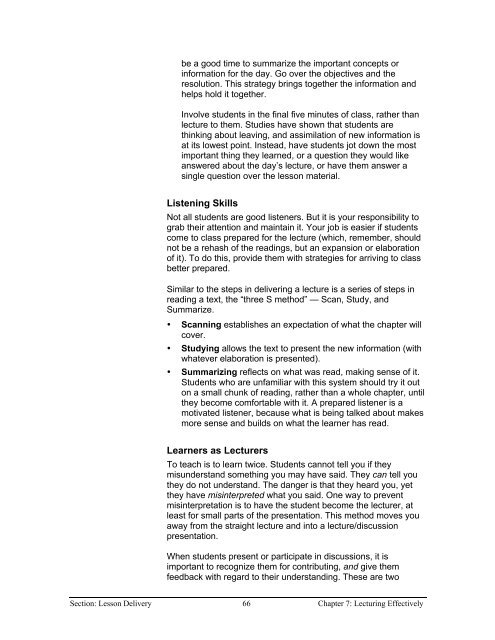Chapter 9 - Instructional Media: Chalkboards to Video - CGISS
Chapter 9 - Instructional Media: Chalkboards to Video - CGISS
Chapter 9 - Instructional Media: Chalkboards to Video - CGISS
Create successful ePaper yourself
Turn your PDF publications into a flip-book with our unique Google optimized e-Paper software.
e a good time <strong>to</strong> summarize the important concepts or<br />
information for the day. Go over the objectives and the<br />
resolution. This strategy brings <strong>to</strong>gether the information and<br />
helps hold it <strong>to</strong>gether.<br />
Involve students in the final five minutes of class, rather than<br />
lecture <strong>to</strong> them. Studies have shown that students are<br />
thinking about leaving, and assimilation of new information is<br />
at its lowest point. Instead, have students jot down the most<br />
important thing they learned, or a question they would like<br />
answered about the day’s lecture, or have them answer a<br />
single question over the lesson material.<br />
Listening Skills<br />
Not all students are good listeners. But it is your responsibility <strong>to</strong><br />
grab their attention and maintain it. Your job is easier if students<br />
come <strong>to</strong> class prepared for the lecture (which, remember, should<br />
not be a rehash of the readings, but an expansion or elaboration<br />
of it). To do this, provide them with strategies for arriving <strong>to</strong> class<br />
better prepared.<br />
Similar <strong>to</strong> the steps in delivering a lecture is a series of steps in<br />
reading a text, the “three S method” — Scan, Study, and<br />
Summarize.<br />
• Scanning establishes an expectation of what the chapter will<br />
cover.<br />
• Studying allows the text <strong>to</strong> present the new information (with<br />
whatever elaboration is presented).<br />
• Summarizing reflects on what was read, making sense of it.<br />
Students who are unfamiliar with this system should try it out<br />
on a small chunk of reading, rather than a whole chapter, until<br />
they become comfortable with it. A prepared listener is a<br />
motivated listener, because what is being talked about makes<br />
more sense and builds on what the learner has read.<br />
Learners as Lecturers<br />
To teach is <strong>to</strong> learn twice. Students cannot tell you if they<br />
misunderstand something you may have said. They can tell you<br />
they do not understand. The danger is that they heard you, yet<br />
they have misinterpreted what you said. One way <strong>to</strong> prevent<br />
misinterpretation is <strong>to</strong> have the student become the lecturer, at<br />
least for small parts of the presentation. This method moves you<br />
away from the straight lecture and in<strong>to</strong> a lecture/discussion<br />
presentation.<br />
When students present or participate in discussions, it is<br />
important <strong>to</strong> recognize them for contributing, and give them<br />
feedback with regard <strong>to</strong> their understanding. These are two<br />
different things. Communication is reduced if you embarrass a<br />
student by implying that her question or answer is stupid. To do<br />
Section: Lesson Delivery 66 <strong>Chapter</strong> 7: Lecturing Effectively<br />
so is <strong>to</strong> build a barrier that is difficult <strong>to</strong> overcome. Also, other<br />
students in the class will quickly learn that they <strong>to</strong>o could become<br />
the target of ridicule and will hesitate before participating in
















